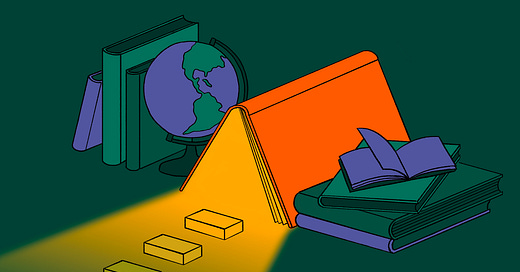The New York Times published a story today about Substack’s rise as a destination for political coverage, and noted some growth stats along the way. One of the numbers that was quietly slipped into the piece: there are now more than 4 million paid subscriptions to publications and podcasts on Substack.
When thinking about numbers at internet scale, it’s easy to gloss over a number like 4 million. But 4 million is a large number. It’s large enough to populate an entire country, with its own system of governance, its own culture, its own hopes, dreams, disappointments, dramas, comedies, tragedies, and epics.
In any case, it’s a large number to me. I remember very clearly the days before Substack existed. I remember very clearly when there were zero paid subscriptions to anyone or anything on Substack. That there are now 4 million feels something like a miracle.
One day in 2017, within weeks of Substack’s launch, I walked into a San Francisco bookstore that specializes in cookbooks and told the owner that my friend and I had just started a platform for writers, and that I thought it could be good for food writers in particular. I knew that the store hosted events for authors who were launching their books. I asked if she thought any of the authors might be interested in this new way to build an audience and make money. I didn’t get much more than a blank look and a polite smile.
On Thursday last week, my wife noticed that a writer she subscribed to was visiting San Francisco and would be giving a talk at the bookstore that night. We had met the writer,
, at a drinks event Substack hosted in London around this time last year. This time, one of my colleagues invited Nicola to stop by the office. I only got to say a brief hello on my way to a meeting, but it was great to see her. It was especially meaningful to me—in the small, emotional kind of way that somehow always sticks to my bones—that she was going to be talking about her much-acclaimed book, Sift, at the bookstore. My wife was able to go to Nicola’s talk that night. The room was overflowing.This morning, I got an email from a writer who was bringing my attention to an interview he had done with Nicola for his own Substack. He wondered if I would be open to promoting the interview since Nicola was “a true Substack success story.” (There you go, Brian.) Nicola had started publishing on Substack four years ago, the writer noted, and is now a bestselling author. In the interview, Nicola described being discovered on Substack by an agent who asked if she had ever considered writing a book. A year and a half later, she decided she was ready. The resulting book has now been praised by Nigella Lawson, Nigel Slater, Yotam Ottolenghi, and Jamie Oliver, to name a few.
While politics is the largest category on Substack and tends to draw most of the media attention, I am equally proud of the incredible diversity of work being published here from writers and creators of all backgrounds and across categories. It’s not just a new generation of food stars like Nicola,
(who also has a Substack-incubated bestseller), and Violet Witchel of dense bean salad fame. Fashion is on the rise here, too, as the media are starting to notice, with some going so far as to say “Substack is the new Instagram.” A few days ago, the author posted on Notes that his poems have been read more than 1 million times on Substack. Podcasters, including recent arrivals and , are also thriving here. And video shows from the likes of and are an increasingly prominent part of the platform. Every Saturday, we show off an eclectic range of art, photography, film, animation, and writing in The Weekender, a flight of the best tipples from across the network, all brought together in the Substack app.This is a new kind of media ecosystem. It’s like traditional media with community, or social media with property rights. It is a world of worlds; communities built around ideas and cultural leaders, where anyone gets a shot regardless of pedigree. It’s a system designed specifically to help writers and creators succeed, and for everyone to find ideas and ideals to fall in love with.
And it’s working. Nicola Lamb and millions of subscribers can attest to that. It’s working because of you. We’ve shipped a lot of features recently—from new publishing tools to new growth functions to collaborative livestreaming—but by far the most important feature of this platform is, and always will be, the people.
While other platforms cater to advertisers, addictions, or the addled, we will always fixate on how we can best serve you: the people who create and care about culture; the people who seek quality and connection. That’s why Substack’s business model is intrinsically tied to creator success. We can only make money when creators make money. Creators can only make money when their subscribers are happy. It’s a good system. Thank you for building it with us. Let’s keep it going.







You know what’s cooler than 4 million subscribers? 4 billion. We are the media now.
I beg to differ. It is a success for the many people who are publishing creative, material, political, material, and opinion and collecting monthly income on Substack. And I don’t begrudge them. BUT, We have to make sustainable alternative media.
I have many subscriptions that I’ve just added up, and it’s about $100 a month. I can’t afford that. I need a Network. My most recent subscription is to Meidas network, because they are the only people who are even paying lip service to developing a network. Maintaining several $5 and $10 subscriptions for people who are retired or work for low wages is simply not sustainable for those of us who pay. There has to be a better way.